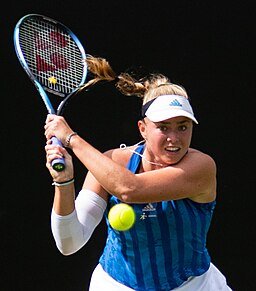Twenty-four-year-old Emily Appleton, is one of countless tennis players criss-crossing the globe, endeavoring to eke out a career, in a sport which rarely offers free rides to the top. To make it onto the courts at Wimbledon, requires years and years of dedication. Hundreds of thousands of kms of air, and car miles. And more than likely, expenditure of hundreds of thousands of dollars along the way.
It’s not a journey that sounds alluring, yet every week around the world, thousands of players are fighting for that one extra point, that one more game, that one more win, which might see them climb just one more rung up the ladder of the tennis world.
For the British native, born on the outskirts of London, Emily grew up engrossed by the grass court summer, dreaming of one day competing at the All England Club. Emily had tennis in her genes from a young age, with father Michael having had a career as a tennis professional, competing in the doubles main draw at Wimbledon, 4 times.
Yet the journey from picking up a racket for the first time, earning that first WTA point, and then making it on to the biggest stages in world tennis, is a long one. A tough one. Unforgiving.
For Emily, it’s been all that, but her journey is a long long way from being finished. In fact, one feels it’s just getting started. Emily picked up a racket at age 3, and carved out a very successful junior career. She reached a career high of 10 in the world on the junior stage, and held British titles in the Under 12, 14, 16, and 18 age groups. In her final year of schooling, she was juggling a semi-professional tennis career with full-time education, which meant she had no choice, but to write essays on planes, and sit exams in Paris whilst competing in the French Open Junior Slam.
By the time Emily had finished her junior career, she had notched up 4 ITF Junior titles across 3 surfaces, made the quarter-finals of the Australian Open, and had a 70% winning percentage. But time waits for no-one, and once she turned 18, the relative comfort of the junior tour gave way to the women’s tour on a full-time basis. Realistically though, Appleton had already been playing the majority of events on the ITF women’s tour, and had moved to a world ranking of 898 after her final Junior US Open.
However, the transition from juniors to seniors is one that can certainly break some individuals. While it could be easy to get frustrated seeing other juniors of your age making it look easy, Emily spoke to ‘The Tennis Site’ about that transition.
“The junior and professional tours are extremely different and it is tough to compare the two. Everyone’s journey post juniors is different, so it is not really possible to compare, or track progress with another player, and it is not advisable either! As such, you almost have to learn as you go, making the best out of every situation and not assume guaranteed success straightaway, even if you have had a golden junior career.”
“I think initially one of the hardest things to adjust to is the transition from being one of the top junior players in the world, playing in all of the big tournaments and junior grand slams, and getting the luxury treatment. To then having to adjust to the grind of the pro tour, where you have to start from scratch, hustling the lowest level of the tour where nothing is given to you, and have to work your way up the ladder again.”
“Another challenge is that on the pro tour, everyone can play, and everyone fights like mad. We are all playing for our living, so the tour has a different feel to juniors – it is less friendly and much more cut throat and competitive.”
But hustle is exactly what Emily did. In 2018/19, her first 2 years on the women’s tour, Appleton played close to 60 tournaments, usually entering both singles and doubles as a way to supplement the small income on the ITF circuit. By playing so many events, she was able to lift her ranking into the low 500’s. However, breaking out of that ‘500’ range is not always straight-forward. In fact, it can often be a lot harder to move up the rankings at this level, than it can be for players at a higher level.
“The difference in level between the 300-500 player and the top 100/200 player really isn’t that big. We can all play to a very high level, but the issue is being given the chance to break through, which is not always easy as tournament cut offs are brutal, and the lower ranked players simply can’t get into the tournaments to earn the bigger points on offer.
Often the hardest part of the tour is the breaking through to the top 100/150/200 etc and then once you eventually make it through it is actually ‘relatively easy’ to stay there.
By ‘relatively easy’, let’s take an example of a player ranked 500. To gain direct entry into a W50 level event, this player will likely have to go through qualifying. Should they wish to avoid playing qualifying matches, they’ll most likely need to step down to a W35 event. That means 35 points for a title win (5 matches). Winning two rounds, will net a player just 14 points.
Compare this to a player ranked roughly 150, who can potentially sneak into a WTA250 event, where just one win will add 54 points to their tally, two wins, 98 points. In a nutshell, a player has to win 15 matches in a row on the ITF tour, to equal the points from 2 wins in a 250 event. It really is a system set up to make ascending up the rankings extremely difficult.
But for Emily, that’s fine, and she can deal with that. However, when circumstances are taken out of your hands, it adds a whole new layer of frustration and disappointment.
“I don’t think it helps that the WTA/ITF tours don’t seem to communicate, and are constantly changing the points and ranking structures. A few years ago, the ITF introduced a change to the ranking structure which saw me go from 500 to 750 overnight for nothing. This hugely affected my confidence, and whilst the ITF then realised a year later that this change was not proving to be successful, it was too late. Players weren’t able to get their ranking back to where it had been, and the damage had already been done. So sometimes, progress lies in the hands of the ITF, which is a worrying thought!
In October 2022, Appleton found her ranking had slumped outside the top 1000, but she wasn’t about to throw in the towel. A 7-match win streak from qualifying, en-route to the Loughborough 25K title, re-invigorated her career, and saw her jump back up inside 500 by the end of the year.
But the challenges of being stuck around that 500 mark, aren’t just limited to the massive points discrepancy. There is the not so small matter of finances, as well as a lack of clarity around planning a schedule. This is something Appleton feels strongly about when discussing what could be done to improve the ITF tour for lower-ranked players.
“I think it is important that the ITF tackles the issue of covered accommodation for female players. The ATP Challenger Tour organises all the men’s tournaments higher than the $25K level. In the challenger events (so everything above 25K level) all accommodation (which is one of the biggest expenses on tour) is covered by the tournament and is free for the male players. On the women’s side, the ITF handles all tournaments up to $100K level but accommodation is only covered at $100K events (nothing below) and even then, it is only for main draw players. This increases our expenses considerably compared to the men’s side and really affects which tournaments we can play.”
Nonetheless, over the last 18 months, Emily has continued her rise, reaching her career singles high of 368, and a doubles ranking of 125. With that ranking creeping closer to double digits, it may mean there are difficult choices to make when it comes to entering tournaments. Will the temptation be, to put more focus on the doubles, and attempt to push into the bigger events where there is more money, and a better lifestyle? Or will singles remain as the focus?
“At the moment I am balancing my singles and doubles, as both are equally important to me to continue. I don’t believe that I have fulfilled my potential yet in either discipline, so I want to really push to get both rankings higher. Of course, when the opportunity presents itself to play in higher tournaments for my doubles, I will do this but I will also ensure that I play other tournaments for my singles too. I also believe that continuing with both disciplines aids my game, and they benefit each other.”
Emily is lucky enough to have a wonderful support network around her, including her mum Sally, who writes a very informative and entertaining blog about the real tour life. In addition to that though, Emily points out that having support from her fellow peers can make life on the road a little easier.
“Since Covid and with more players training at the National Tennis Centre nowadays it definitely feels as though the players are supporting one another more so now, and following each other’s results and progress. At the end of the day, we are all competitors out for ourselves, but it is definitely nice to travel to tournaments where other Brits are, as it makes it slightly less lonely.”
But for now, Appleton isn’t travelling too far from home. With the British grass court season about to kick into high gear, Emily has started her campaign at the Surbiton 100K this week, where she has made it through qualifying, into the main draw. As for her plans to follow:
“There are also a couple of WTA’s that I hope to sign in for, and of course the grass season finishes with Wimbledon which I would love to be part of again this year if I can.
As for my goals for the rest of the year, I want to continue to push both of my rankings higher (singles and doubles) and obviously attaining a top 100 doubles ranking would be a great achievement for me. At the same time, I also want to continue to focus on the process and my game development as then the rankings will take care of themselves.”
Emily Appleton Player Profile:
Career High Singles Rank: 368
Career High Doubles Rank: 125
Titles: 3 ITF singles, 19 ITF doubles
Favourite surface: Grass
Favourite shot: Smash
Favourite tournament played: AO Juniors or Wimbledon as a Pro
Favourite country to visit: USA or anywhere in Scandinavia
If I could win one tournament: Wimbledon
Favourite female player to watch: Karolina Muchova
Favourite male player to watch: Jannik Sinner
Tennis idol growing up: Sam Stosur
Follow The Tennis Site ‘X’ and Facebook @thetennissite
Follow Todd Scoullar on ‘X’ @ToddScoullar

